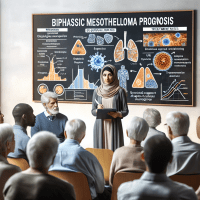Mesothelioma Survival Rate Research Insights
Introduction
Hello, I’m an experienced oncology patient educator and advocate who has dedicated years to supporting individuals and families navigating the complexities of mesothelioma. Today, I share my personal insights and research findings on mesothelioma survival rates. Drawing from trusted sources such as the National Cancer Institute (NCI), American Cancer Society, and the Mesothelioma Applied Research Foundation, I aim to provide comprehensive and compassionate guidance to the mesothelioma community.

This post covers essential research on mesothelioma survival rates, including crucial factors such as patient age, stage of diagnosis, and treatment options. As someone who has stood at the forefront of patient education, I understand the need for clear, actionable information presented in an empathetic tone. Together, we will explore the latest in mesothelioma survival rate research while acknowledging the very human experiences behind the statistics.
Understanding Mesothelioma Survival Rates
Mesothelioma survival statistics are complex, reflecting the challenges clinicians face in treating this aggressive cancer. Broadly, the metrics vary based on many patient-specific and disease-specific factors. Keywords such as mesothelioma survival rates, mesothelioma prognosis, and mesothelioma life expectancy frequently appear in research and medical literature, and for good reason – they guide treatment decisions and provide hope for those affected.
Over the years, numerous studies have examined mesothelioma survival rates by treatment and mesothelioma survival rates by stage. For example, survival statistics often differ if the disease is detected at an early stage versus a more advanced one. Factors like the patient’s age, overall health status, and even gender can significantly affect outcomes, which is why you might encounter terms like mesothelioma survival rates by age and mesothelioma survival rates by gender in academic discussions.
It is important to note that while these statistics provide a general outlook, they do not determine an individual’s fate. Each patient’s situation is unique, and survival rates must be considered in context. I encourage you to discuss these details with your healthcare provider, who can offer personalized insights into your case.
Factors Influencing Mesothelioma Prognosis
Stage at Diagnosis and Histological Type
The stage of mesothelioma at diagnosis is one of the most significant factors that affect survival statistics. Early detection often leads to better outcomes. The type of mesothelioma, whether pleural, peritoneal, or pericardial, also plays a critical role. Research showing mesothelioma survival rates by type highlights how treatment strategies are tailored according to the histological characteristics of the tumor.
Treatment Modalities
Advancements in treatment options continue to evolve. Modern therapies include surgery, chemotherapy, and radiation, as well as multimodal approaches that combine the best available options. More recent studies even explore immunotherapy and targeted treatments, which offer new hope. If you’re interested in detailed treatment alternatives, check our internal resource on Mesothelioma Treatment Options.
It’s also pertinent to note that survival rates differ based on the chosen treatment plan. For instance, mesothelioma survival rates by treatment vary for patients undergoing surgery versus those receiving palliative care. I have observed that personalized treatment plans, designed with compassion and an unwavering commitment to patient well-being, can make a tremendous impact on quality of life and overall prognosis.
Patient-Specific Considerations
In my journey working with countless patients, I have seen how a deep understanding of individual factors such as the patient’s environment, support system, and co-existing medical conditions can influence survival outcomes. This is why many studies now analyze mesothelioma survival rates by stage and even extend the analysis by looking at demographics such as gender and age.
Visualizing Mesothelioma Staging & Treatment Options
Below is a medically accurate diagram that illustrates the stages of mesothelioma and correlated treatment approaches. This diagram not only aids in capturing the progression of the disease but also demystifies the treatment pathways often discussed in clinical research.

Understanding these stages is crucial. Early stages often allow for more aggressive treatment options, which can potentially improve the mesothelioma survival rates. As a patient advocate, I ensure that every mesothelioma diagnosis is accompanied by thorough discussions around these stages and what they mean for your treatment journey.
Patient Perspectives and Emotional Support
Living with mesothelioma is an emotional journey as much as it is a medical one. Over the years, I have witnessed the tremendous courage and resilience of patients who, despite daunting survival statistics, continue to fight the disease with hope and determination. Sharing in their journey has taught me that every piece of research is not just a number—it represents human lives, dreams, and families.
In addition to clinical data like mesothelioma survival statistics, I advocate for robust emotional support. Patients and caregivers alike face emotional stress that can affect treatment outcomes. That’s why I encourage exploration of internal resources such as our Emotional Support Resources for Mesothelioma Caregivers, which provide valuable guidance and community connections.
While statistics such as mesothelioma survival rates by stage and mesothelioma survival rates by treatment provide a framework, the human experience behind those numbers requires empathy, understanding, and support. These elements are vital in navigating the maze of cancer care.
The Latest in Mesothelioma Research as of June 2024
The landscape of mesothelioma research is continually evolving. As of June 2024, new clinical trials and breakthroughs are offering fresh perspectives on long-term survival, particularly through innovative treatment combinations and early intervention strategies. Research is particularly focused on personalized medicine—tailoring treatments to individual genetic and biological profiles to enhance outcomes.
For example, recent studies published by reputable institutions have begun to unpack mesothelioma survival rates by age and mesothelioma survival rates by gender, suggesting that demographic factors might influence how patients respond to treatment. These findings underscore the importance of personalized approaches in modern oncology.
By keeping abreast of the latest research, I remain committed to sharing not only the statistical data but also the evolving narratives that offer hope and direction to the mesothelioma community. It is this blend of robust data and heartfelt advocacy that continues to drive our mission forward.
Resources, Transparency, and Final Thoughts
Throughout my work as an oncology advocate, I believe in transparency and the importance of unbiased, supportive information. To this end, I want to share an unobtrusive yet essential note: our site receives support that helps maintain educational resources; however, our primary focus remains being a voice for accurate, compassionate patient education. This transparency statement is meant to assure readers that our content is driven by integrity and an unwavering commitment to patient empowerment.
I encourage anyone navigating this challenging journey to consult directly with healthcare providers for personalized advice. The insights shared here—from detailed survival statistics like mesothelioma survival rates by type to personal reflections on the importance of emotional support—are intended to complement, not replace, medical guidance.
In closing, let us remember that behind each statistic is a story of resilience and determination. Whether you are a patient seeking clarity, a caregiver in search of guidance, or a loved one supporting a family member, know that there is a community and robust body of research dedicated to improving outcomes and quality of life for those affected by mesothelioma.
Feel free to explore our additional resources on topics such as Mesothelioma Treatment Options and Emotional Support Resources for Mesothelioma Caregivers to further empower your journey.






